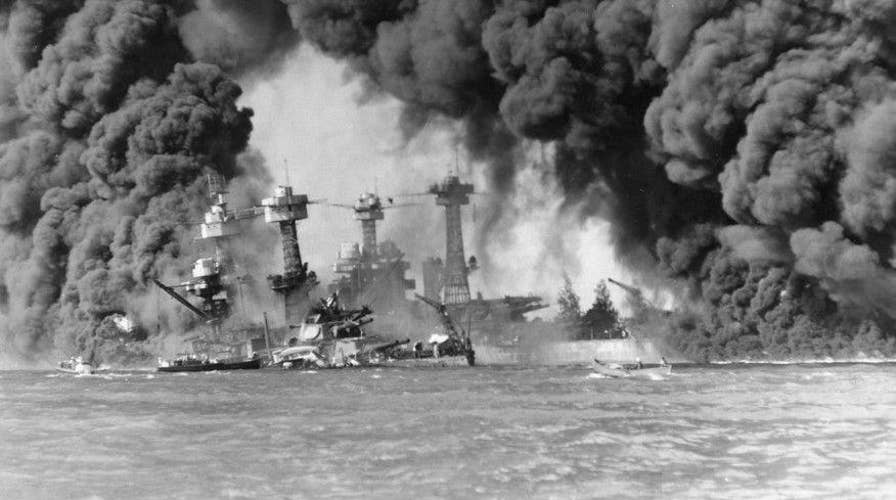Breakdowns, missed clues that led to attack on Pearl Harbor
Insight from Steve Tumi, Pulitzer Prize-winning reporter and author of 'Countdown to Pearl Harbor: The Twelve Days to the Attack'
December 7, 1941, began like any other day for Jimmy Lee.
The self-described “rascal and nosy little kid” was 11 years old, feeding the pigs on his parents farm on the shores of Hawaii.
Then, a plane suddenly buzzed over the treetops, followed by the roar of engines in the skies. Jimmy rushed to the train tracks near his home, believing another war game was taking place. But then he saw it in the distance: explosions rocking American battleships and planes swarming the area like wasps.
The Japanese attack on Pearl Harbor was under way.
“I never saw anything like this in all my life,” Lee recalled to FoxNews.com. “We really thought it was a war game. It was astonishing to see all the things that were happening above.”
FULL COVERAGE OF THE 75TH ANNIVERSARY OF THE PEARL HARBOR ATTACK
Lee, 86, is just one of a shrinking number of living veterans and witnesses to have experienced the attack firsthand, and on its anniversary, he and historians who have studied America’s “Date of Infamy” say there are still lessons to be learned from what happened at Pearl Harbor 75 years ago.
“My big concern is that when we came about World War II . . . people just got together, we didn’t care,” said Lee, who still lives in Hawaii. “Everyone got together to support and help each other.
“One of the things I worry about now is should something happen are we going to be the same? Are we going to be together as one country, whether we like it or not?”
Lee – who went on to serve for the Army in Europe during the early 1950s – now hopes to instill those same values in younger generations, working as a volunteer with the National Park Service to speak to students in classrooms.
Students throughout the country are going on an “electronic field trip” Wednesday with the help of the National World War II Museum in New Orleans and PBS member station WYES, which are broadcasting a free live webcast of Pearl Harbor-themed programming for grades 5-8, including “on-the-scene reporting from students with survivors and witnesses of the attack.”
The museum will host free events throughout the day, including a commemoration ceremony, a military band performance and panel discussions.
Robert Citino, a senior historian at the museum and a military history scholar who is taking part in the panel, told FoxNews.com that for the threats America faces today, “there is a lesson of Pearl Harbor and it’s that you have to be vigilant."
"It was scary at the beginning because they were flying low enough where you could see the pilots' faces."
He also said Japan’s actions at Pearl Harbor in 1941 offer a cautionary tale to countries of how “you don’t really know what you’re buying when you launch a war.”
The attack left 2,403 U.S. military personnel dead and 169 American aircraft destroyed. But in the coming years the Japanese suffered heavy losses, including the atomic bombings of Hiroshima and Nagasaki that culminated in the end of World War II.
Richard Frank, a National World War II Museum Tour Historian, told FoxNews.com that Japanese Admiral Isoroku Yamamoto – the mastermind of the Pearl Harbor attack -- was not in favor of launching a war with the U.S.
However, given his government’s decision to plan an attack to damage the U.S. Pacific fleet -- so Japan could pursue oil resources in the Dutch East Indies -- Yamamoto felt as if he had to come up with something. So he decided to strike at one of the only vulnerabilities that the U.S. had.
“He clearly understood what Japan’s prospects in a war with the U.S. were,” Frank said.
PEARL HARBOR SAILOR'S FAMILY BRINGS HIM HOME AFTER HIS REMAINS ARE FINALLY IDENTIFIED
Another veteran, Alfred “Al” Rodrigues, woke up at 3:30 a.m. on the day of the attack and went to work as a Navy storekeeper and disburser at a receiving station at the entrance of Pearl Harbor.
He heard rumblings later in the morning from the shipyard side of the facility. After ignoring them, saying the harbor was being dredged, Rodrigues took notice when he heard the message “Man your battle stations this is not a drill” over the intercom.
Rodrigues was handed a Springfield rifle and started firing at the planes above. He knew it was the enemy when he saw the red circles on the planes’ exteriors.
“It was scary at the beginning because they were flying low enough where you could see the pilots' faces,” Rodrigues told FoxNews.com, recalling how he fired at the Japanese. “We know we hit them –- but a 30-caliber rifle is not going to bring a plane down.”
Rodrigues, who is from Hawaii and still lives there, says for a long time he never talked about his experience that day at Pearl Harbor and people didn’t even know he was in the Navy.
But as the 75th anniversary is recognized across America Wednesday, he says a message rings out.
“We need to do a little more loving in this world instead of fighting.”


